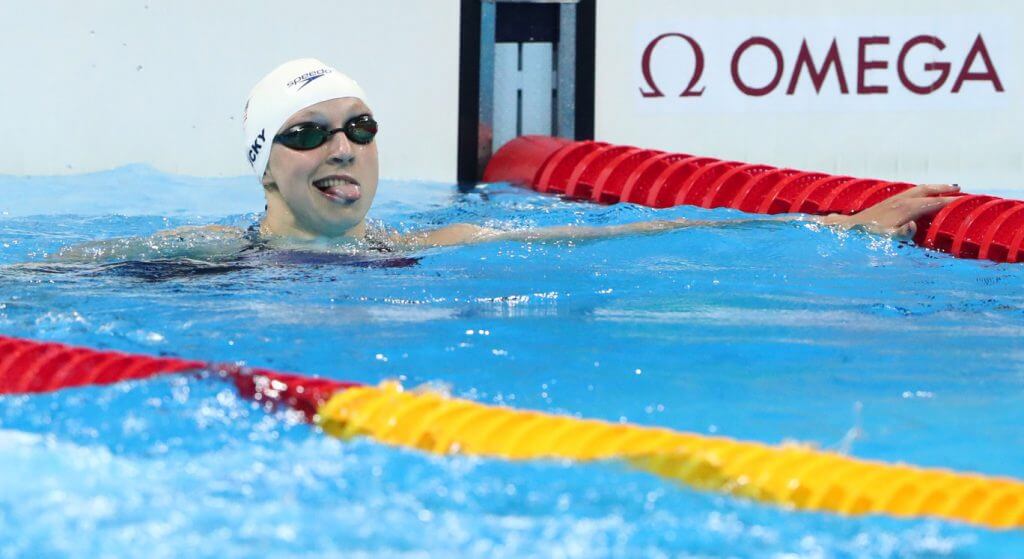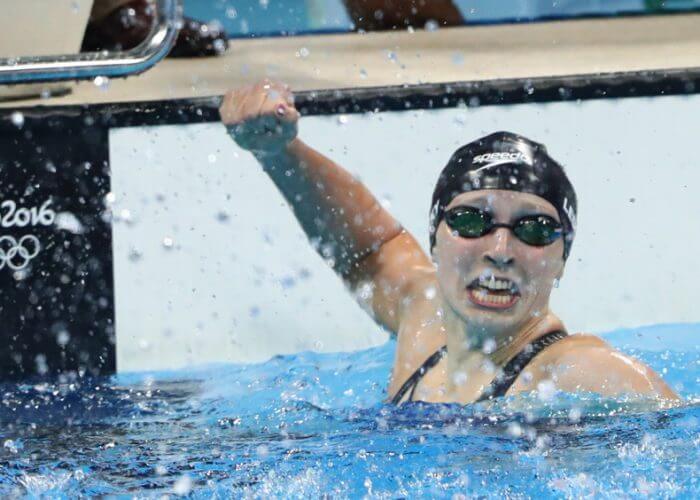Just How Dominant is Katie Ledecky?

By Zach Breeding, Swimming World College Intern.
It’s a very rare thing to see an athlete completely dominate a field and revolutionize a sport in one’s lifetime. However, this is exactly what we are seeing Katie Ledecky do to the sport of swimming. And while her dominance and technique have been sufficiently beaten into the ground by discussion, what has not been put into perspective is her relative dominance in comparison to other more well-known and quantifiable sports.
I will compare the percentage by which Ledecky won her 800m free at the 2016 Olympics to that of past years in the same event. Then, using the difference between the two, I will create a detailed stat report. By applying those differences to other sports’ average winning percentages, a clear disparity will be revealed.
Katie Ledecky Versus History
Anyone who watched these past Olympic Games knows who Katie Ledecky is. She was the one who made all of the other world class swimmers look like children. Katie Ledecky won the 800 freestyle, her most dominant Olympic event, by a margin of over 11 seconds or a difference of 2.3 percent.
In prior years (from 1972 to 2004), the average percentage won by was 0.5 percent. So, the difference between these two is 1.8 percent. This translates to a 324 percent increase in winning percentage. This number, for any sport (regardless of average score), is absolutely staggering. It becomes even crazier when one considers that she is racing the best in the world.
But what is this difference like in comparison to other sports?
Katie Ledecky Versus Everyone Else
As we have established, 324 percent is the percentage difference between Ledecky’s 800 win margin and the combined average of those in the past. So, in making a comparison to their sports I will find the average winning score, find the percentage difference between those two scores, and the increase that to a margin of 324 percent.
Baseball
First, the great American pastime– baseball. Finding an average final score for baseball was not possible due to the sheer number of baseball games which have been played in the history of our nation. What I was able to find was the final score of every MLB game from 1900 to 2006. In analyzing this list, it was revealed that the most common score for a game to end with is 3-2. So, this leaves us with a 50 percent difference in scores.
If we apply what I’m gong to refer to as the KL (Katie Ledecky) Factor, this leads to a final score of 13 to 2, or in other words an absolute blowout. If a team was to consistently win like this as Katie Ledecky does, they would instantly be tested for every performance-enhancing drug known to man and probably be accused of bribing other teams to play poorly.
I do concede however that baseball is an inherently low-scoring sport and not as popular as it used to be. So next we will examine what may be a better metric for helping those unfamiliar with swimming understand just how unprecedentedly fast Ledecky is.

Photo Courtesy: Rob Schumacher-USA TODAY Sports
Football
Football is, bar none, the most popular sport in America. The NFL pulls in an estimated $7.24 billion a year, and they only make up a portion of the football market. I’m going to be using the NFL’s scores as a basis for our average because most people are familiar with how an average game goes in this league as opposed to one like the NCAA. On the professional level we see a smaller disparity in talent which is more comparable to Ledecky racing the best in the world.
The game of football has changed quite a bit since its inception– an entire article could be written about the changing in scores from the 1920s to modern times.
So, with this information in mind, I will be calculating the averages using the scores from the 2016 season. The average final score in a 2016 season NFL football game was 29-18. This, much like the difference from the baseball game, is a 46 percent difference. So, if we apply the KL Factor we arrive at a score of 106-18…
Words cannot describe how poorly the other team would have to play to allow a score like that. The other team would likely be forced out of the league and all the players would resign themselves to the world of sports anchoring which awaits all football players who couldn’t quite make it.
Soccer
But how about what is definitely the world’s most popular and lowest-scoring sport– soccer? At first I thought that this result would be less interesting due to the nature of soccer and the lack of points scored. However, the results are just as astounding.
The average soccer game finishes with a score of 2-1. This is a 50 percent difference, so with the application of the KL Factor we reach a final score of about 8-1. Germany once defeated Brazil 7-1, but seeing a team win by a seven point margin consistently would be obscene.
Katie Ledecky is a phenom who is not only revolutionizing the sport, but revolutionizing what it means to win in general.
All commentaries are the opinion of the author and do not necessarily reflect the views of Swimming World Magazine nor its staff.




Even Serena Williams get beat once in a while. The ONLY athelete that might come close is Eddy Merx.
Not very ? Joe Stott
Easy, it’s The Greatest of all Time, now The 200 free WR, The 100 in The future and : Game Over.
Katie is a female Ian Thorpe.
Tom Kingham
too…..
This lady continues to be awesome!!!!!
Good work, Zach. Really like the perspective of comparing to an average. Plus, the comparison to NFL makes me feel not as bad about the many times the Giants have been blown out the past few seasons!
How does Katie Olympic 800 compare to Secretariat’s run in the 1973 Belmont?
Completely. Not even a relevant question
Are you to young to remember the great Janet Evans in 1988? Even the men distance swimmers hated to workout with her as she never slowed down. Only the steroid laced East German women came close, as several seconds behind her.
It took until 2006 before here 400 meter free record was broken.
Your percentage is not a great way to look at it. You are getting a percent compared to 0 seconds. This is not an achievable time. You should be computing the percentage from the fastest time possible (which I understand is not known, but you can take a stab at it). For sake of argument, say you decide that the fastest time possible by a female human is 7:45, then KL went +19.79 seconds. and Jazz Carlin went +31.17 seconds. In this case the percentage win by KL was 57.5%, not 2.3%. Of course you’ll have to recalculate how much the past winners won relative to the 7:45 theoretical minimum, but those winning percentages will not go up by nearly as much because they are not nearly as close to that theoretical minimum.
This is basically akin to pointing out that the faster swimmers go, the harder it is to win by as much, which I’ve noticed is pointed out rarely at best.